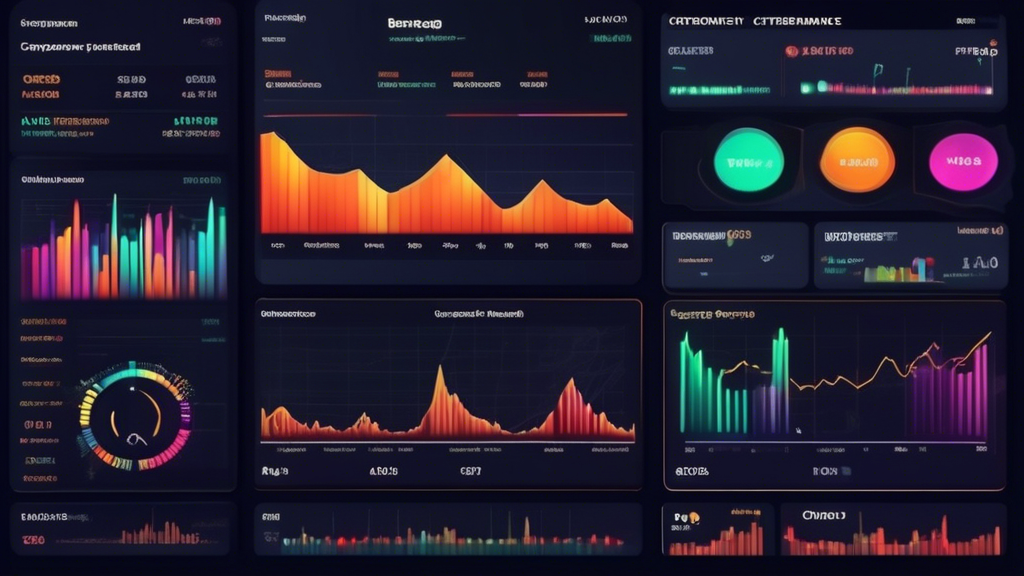Understanding Margin Trading in Crypto: Risks and Rewards What is Margin Trading in Crypto? A…
Evaluating Performance in Crypto Trading: Strategies and Insights

In recent years, cryptocurrency trading has surged in popularity, attracting investors and traders worldwide. The allure of significant returns, the decentralized nature of digital currencies, and a rapidly evolving market have made crypto trading an intriguing endeavor for both novice and seasoned traders. However, in the dynamic world of crypto trading, evaluating performance is crucial for making informed decisions. Effective performance evaluation not only guides traders in optimizing their strategies but also aids in identifying trends and refining investment approaches. This article delves into the core strategies and insights essential for successfully evaluating crypto trading performance.
As traders navigate this fluctuating landscape, understanding the intricacies of performance evaluation becomes imperative. By focusing on key metrics like Return on Investment (ROI), the Sharpe Ratio, and Win Rate, traders can attain a comprehensive view of their trading effectiveness. Regular monitoring of these metrics is paramount, as it informs traders about the efficacy of their strategies, risk exposure, and potential areas of improvement. Moreover, top traders exemplify the importance of these metrics, leveraging them to fine-tune their approaches and sustain profitability.
Meanwhile, evaluating performance in crypto trading is not limited to metrics alone. Adopting effective strategies such as backtesting can provide insights into past performance, helping traders anticipate future outcomes and adjust their tactics accordingly. Diversification of assets emerges as another critical strategy, mitigating risks and contributing to a robust evaluation framework. Additionally, the integration of advanced analytics and AI tools further empowers traders, offering sophisticated means to dissect trading data and enhance decision-making processes.
Furthermore, staying abreast of industry insights and adopting best practices are key to thriving in the crypto market. Successful traders emphasize the importance of emotion management, recognizing that psychological factors can heavily influence trading outcomes. By balancing technical analysis with emotional resilience, traders can maintain consistent performance. Looking ahead, understanding future trends in crypto trading and anticipating their impact on performance evaluation strategies will be vital for continued success in this ever-evolving domain.
For further exploration on the subject, resources like [CoinMarketCap’s Education section](https://coinmarketcap.com/alexandria/) and [Investopedia’s Crypto section](https://www.investopedia.com/cryptocurrency-4427699) offer comprehensive guides and insights into cryptocurrency trading and performance evaluation.
Introduction to Crypto Trading and Performance Evaluation
The landscape of financial trading has dramatically transformed with the introduction of cryptocurrencies, marking a notable shift from traditional trading systems. The rising popularity of cryptocurrency trading has garnered significant attention not just among professional traders but also among everyday investors. Cryptocurrencies, with Bitcoin leading the charge, have opened new avenues for profit and investment, drawing millions globally towards this exhilarating yet volatile market. This rise is fueled by several factors, including the potential for high returns, the appeal of a decentralized currency system, and the increasing adoption of blockchain technology across different sectors.
- High Potential Returns: Cryptocurrencies can offer substantial gains, often within short periods, which makes them attractive to both new and experienced traders.
- Decentralization: Unlike traditional currencies, cryptocurrencies operate without a central authority, offering more autonomy to users.
- Blockchain Technology: The underlying technology of cryptocurrencies promises innovation in various industries, enhancing its appeal.
Amidst this popularity, the importance of evaluating performance in crypto trading becomes paramount. The volatile nature of the cryptocurrency market means that prices can fluctuate wildly, often within hours or even minutes. Therefore, traders must develop a robust methodology to assess the effectiveness of their trading strategies. Evaluating performance not only helps traders understand their success rates but also aids in identifying potential pitfalls and needed adjustments, thus facilitating better decision-making.
| Reasons for Performance Evaluation in Crypto Trading |
|---|
| Identifying strengths and weaknesses in trading strategies |
| Improving future trading decisions |
| Recognizing patterns and trends in past performance |
| Gauging the effectiveness of risk management techniques |
In the context of crypto trading and performance evaluation, it is crucial to not only execute trades but to strategically evaluate them to achieve consistency and longevity in the market. This evaluation involves scrutinizing various performance metrics, a subject that the following sections will address in greater detail.
Cryptocurrency markets are often characterized by high volatility and unpredictability. As a result, traders must leverage effective strategies and insights to gauge their performance adequately. Performance evaluation in crypto trading is not only about the realization of gains and losses but also involves understanding the comprehensive landscape of trading activities. Applying structured evaluation techniques enables traders to refine their approaches and enhance their overall trading acumen.
The focus on applying strategies for successfully evaluating crypto trading performance revolves around several core areas. These strategies include the in-depth monitoring of trade outcomes, the application of analytic tools, and a conscious awareness of market trends—all aiming to not only amplify profit but also manage risk effectively.
- Monitoring Trade Outcomes: Regular analysis of which trades perform well can offer insights into market conditions and trader efficacy.
- Use of Analytic Tools: Leveraging trading platforms and tools that provide real-time data and performance metrics can significantly enhance decision-making.
- Awareness of Market Trends: Being aware of broader market movements and sentiment is crucial for adapting trading strategies effectively.
Traders often find that integrating these elements into their routine leads to enhanced strategic planning and execution. Given the dynamic and complex nature of crypto markets, continual learning and adaptation are essential.
For further detailed information on crypto trading basics, refer to resources like Investopedia’s Crypto Trading Tips. This could provide a foundational understanding for those new to cryptocurrency trading.

Key Metrics for Evaluating Crypto Trading Performance
Successful crypto trading relies not only on intuition or timing but on a quantitative assessment of one’s strategies and outcomes. Evaluating performance involves understanding key metrics that can provide valuable insights into the effectiveness of trading strategies. Let’s delve into some of the essential performance metrics used by seasoned traders to assess and enhance their crypto trading endeavors.
1. Return on Investment (ROI)
- Definition: ROI measures the gain or loss generated relative to the amount of money invested, giving traders an insight into the profitability of their trades.
- Formula: ROI = (Net Profit / Investment Cost) x 100
- Usage: By calculating ROI, traders can gauge the efficiency of their investments and compare profitability across different crypto assets.
Tracking ROI helps in understanding which trades or strategies yield the highest returns, thereby assisting traders in refining their future investment choices. For more details on ROI, visit Investopedia’s ROI Guide.
2. Sharpe Ratio
- Definition: The Sharpe Ratio assesses the risk-adjusted return of an investment, enabling traders to determine how much excess return they’re receiving for the extra volatility endured.
- Formula: Sharpe Ratio = (Mean Portfolio Return – Risk-Free Rate) / Standard Deviation of Portfolio Return
- Importance: A higher Sharpe Ratio indicates that a trader is achieving greater returns per unit of risk, thus making it a critical measure for evaluating the wisdom of a trading strategy.
The use of the Sharpe Ratio is popular among traders who want to ensure they are being adequately compensated for the risks they are taking. Learn more about the Sharpe Ratio.
3. Win Rate
- Definition: The Win Rate is the percentage of trades that result in a profit over a set period.
- Calculation: Win Rate = (Number of Winning Trades / Total Number of Trades) x 100
- Explanation: A high win rate indicates a successful strategy or trader, albeit with considerations for the accompanying risk and reward profile of the trades.
Tracking your win rate helps identify successful patterns and potential areas in need of adjustment. For a comprehensive exploration of win rate calculations, check out Tradingsim’s article on Win Rates.
The Importance of Regular Tracking
Inconsistent tracking of these metrics could lead to misguided trading decisions. Regular monitoring ensures:
- Informed Decisions: Provides a clear picture of past performance to guide future trading choices.
- Identifying Strengths and Weaknesses: Facilitates the identification of strategies or assets that perform well or poorly, enabling targeted refinement.
- Risk Mitigation: Helps manage and mitigate potential risks associated with volatile market conditions by understanding risk-adjusted performance.
Successful traders often incorporate these metrics into their trading plan for continual refinement and efficiency. They may use trading journals, software tools, and platforms to keep meticulous records of these metrics.
Real-World Application by Successful Traders
- Backtesting with Metrics: Traders often use backtesting to simulate trades using historical data and calculate ROI, Sharpe Ratio, and Win Rate to validate their strategies.
- Diversification Strategies: By analyzing these metrics, traders can diversify their portfolios in order to balance risk and enhance their Sharpe Ratio.
- Algorithmic Adjustments: High-frequency traders leverage algorithmic trading systems that automate adjustments based on real-time metrics assessments.
Traders who consistently outperform often have a disciplined approach to tracking these key performance indicators, leveraging them to fine-tune their strategies in response to shifting market dynamics.
In conclusion, understanding and implementing these key metrics is pivotal in optimizing crypto trading performance. For those interested in a dive deeper, you can explore online platforms that offer in-depth guides and tools for measuring and improving your trading metrics.

Effective Strategies for Performance Evaluation in Crypto Trading
Backtesting in Crypto Trading
Backtesting is an essential strategy in crypto trading and performance evaluation. By simulating trades using historical data, traders can assess the effectiveness of their strategies before applying them to live markets. This practice not only provides insights into potential outcomes but also highlights possible risks and returns.
- Importance: Backtesting allows traders to understand how their strategies would have performed in the past, providing a framework for future decision-making.
- Implementation: Utilize backtesting software or platforms such as TradingView or Coinigy to assess your strategies.
- Considerations: Ensure the historical data is accurate and consider market conditions that could influence outcomes differently.
Find more about backtesting tools: Investopedia Guide to Backtesting
Diversification’s Role in Performance Evaluation
Diversification is a key strategy in evaluating and enhancing crypto trading performance. By spreading investments across various cryptocurrencies, traders can reduce the risk associated with any single asset.
- Benefits: Minimizes risk exposure by investing in a mix of assets, which can offset losses in one asset with gains in another.
- Strategy Implementation: Construct a diversified portfolio with a mix of high-market-cap and low-market-cap coins to balance potential risks and rewards.
- Performance Evaluation: Regularly assess the performance of the diversified portfolio against central metrics like ROI and volatility.
For more on diversification strategies, check this resource: CoinDesk Learn
Utilizing Advanced Analytics and AI Tools
Advanced analytics and AI tools have transformed crypto trading and performance evaluation, enabling traders to make more informed decisions through data-driven insights.
- Analytics Tools: Platforms like Glassnode and IntoTheBlock provide on-chain and market data analytics.
- AI Development: AI-driven platforms such as Numerai offer predictive insights by analyzing large datasets to identify trends and opportunities.
- Application: Use these tools to track patterns, forecast price movements, and optimize trading strategies for better performance evaluation.
Explore AI tools for crypto trading: BuiltIn AI Resource
Integration for Enhanced Performance Evaluation
To enhance crypto trading and performance evaluation, integrate these strategies seamlessly into your trading plan:
- Consistent Backtesting: Periodically test your trading strategies to account for changing market conditions.
- Portfolio Rebalancing: Regularly review and adjust your diversified portfolio to ensure optimal asset allocation.
- Utilization of Tools: Leverage the latest analytics and AI tools for continuous performance monitoring and adjustment.
For further insights, refer to: TradingView
Integrating these strategies into your trading routine can significantly improve the accuracy and effectiveness of your performance evaluations, leading to more informed decision-making and potentially better trading outcomes.

Insights and Best Practices for Continued Success in Crypto Trading
As the digital currency market continues to evolve, so do the strategies and methodologies for achieving and evaluating consistent success. The world of crypto trading is known for its volatility, requiring traders to not only understand the market but also manage their emotions and continuously update their strategies based on emerging insights and trends.
Insights from Top Traders and Analysts
Learning from the success of top traders can provide valuable perspectives on crypto trading and performance evaluation. Here are some key insights:
- Risk Management: Expert traders emphasize the importance of having a solid risk management strategy. This includes setting stop-loss levels and ensuring that no single trade can significantly impact your portfolio.
- Continual Learning: The crypto market is dynamic, and continuous education on market trends, technological advancements, and regulatory changes is crucial. Many top traders dedicate time each day to learning something new about the market.
- Networking: Engaging with the crypto community, either through forums, social media, or attending industry events, helps traders stay informed and get different perspectives.
- Automation and Tools: Utilizing trading bots and analytical tools can help in achieving more consistent outcomes by removing emotional distractions and improving decision-making efficiency.
The Role of Emotion Management and Psychological Aspects
Crypto trading isn’t just about numbers and predictions; it’s a mental game. Managing emotions is paramount for maintaining performance:
| Aspect | Impact | Best Practice |
|---|---|---|
| Fear and Greed | Can lead to impulsive decisions such as panic selling or holding onto losing positions too long. | Set pre-defined rules for entering and exiting trades to minimize emotional bias. |
| Overconfidence | May cause traders to take larger risks than justified by their skill level or market conditions. | Self-assessment and reflection post-trade help maintain realistic expectations. |
| Stress Management | Chronic stress can lead to burnout, affecting trading performance. | Incorporate stress-reducing activities like exercise, meditation, or scheduled breaks into your routine. |
Future Trends in Crypto Trading and Performance Evaluation
Understanding emerging trends is vital for staying ahead in the realm of crypto trading and performance evaluation. Some trends that might shape future strategies include:
- AI and Machine Learning: These technologies are increasingly being used to predict market movements and optimize trading strategies. Resources like this guide offer insights on how to leverage AI in trading.
- Decentralized Finance (DeFi): DeFi projects are changing the landscape, offering new tools and strategies such as yield farming and liquidity staking. Explore more through platforms like DeFi Pulse.
- Regulatory Changes: With growing government interest in regulating the crypto sector, staying informed on potential regulatory changes can help traders adapt quickly.
- Sustainability Concerns: With the increasing emphasis on environmentally sustainable practices, crypto mining’s impact on energy consumption is drawing attention, potentially influencing market dynamics.
Incorporating these insights and practices into your crypto trading routine can significantly aid in improving and evaluating performance. Staying agile and open to evolving trends will set the foundation for long-term success in the volatile world of cryptocurrency trading.
In conclusion, the dynamic landscape of crypto trading necessitates a robust approach to performance evaluation. Given the rising popularity of cryptocurrency as both an investment vehicle and a trading instrument, understanding how to effectively measure performance is crucial for traders at every level. Evaluating performance in crypto trading is not simply about tallying profits and losses; it’s a comprehensive process that involves employing key metrics, effective strategies, and leveraging insights for sustained success.
Key metrics such as Return on Investment (ROI), Sharpe Ratio, and Win Rate play a fundamental role in assessing trading performance. These metrics provide a quantitative basis for evaluating a trader’s effectiveness and enable informed decision-making. Regularly monitoring these metrics ensures that traders can make timely adjustments to their strategies, thereby optimizing their portfolios and maximizing potential returns. Successful traders exemplify the importance of these metrics, as they rely on them to gauge market performance and refine their trading tactics continually.
Effective strategies for performance evaluation also include tools and practices such as backtesting and diversification. Backtesting offers traders a retrospective view of how their strategies would have performed in past markets, serving as a valuable lesson for refining future approaches. Diversification remains a critical strategy as it mitigates risks associated with market volatility—a common characteristic of crypto markets. Furthermore, the integration of advanced analytics and AI tools has revolutionized performance evaluation, offering traders predictive insights and automated decision-making support.
Insights from top traders underscore that while technical metrics are vital, understanding and managing psychological aspects are equally important. Emotional discipline and psychological resilience help maintain consistency and enhance decision-making under market pressures. As we look towards the future, advancements in trading technologies and emerging trends suggest that adaptive performance evaluation strategies will be more important than ever. Staying informed about these trends, and continuously evolving one’s evaluation tactics, can provide traders with a competitive edge in the ever-evolving crypto markets.
Ultimately, the road to success in crypto trading and performance evaluation is paved with ongoing learning and adaptability. By combining these metrics, strategies, and insights, traders can improve their chances of achieving consistent performance and long-term success in the volatile world of cryptocurrency trading.
For more detailed information on metrics and strategies in crypto trading, you might explore resources such as [Investopedia’s Cryptocurrency Explained](https://www.investopedia.com/terms/c/cryptocurrency.asp) or Binance Academy’s [Crypto Trading Strategies](https://academy.binance.com/en) to broaden your understanding and refine your trading practices.





